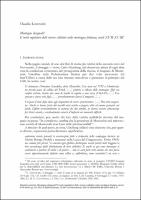Chapter Montagne diseguali? Il ruolo regolatore delle risorse collettive nella montagna friulana, secoli XVII-XVIII
| dc.contributor.author | Lorenzini, Claudio | |
| dc.date.accessioned | 2022-06-01T12:11:55Z | |
| dc.date.available | 2022-06-01T12:11:55Z | |
| dc.date.issued | 2020 | |
| dc.identifier | ONIX_20220601_9788855180535_222 | |
| dc.identifier.uri | https://library.oapen.org/handle/20.500.12657/56039 | |
| dc.description.abstract | Among the structural elements characterizing the Alpine communities in comparison to those in the plains was the specularity of their landscapes: large collective areas (woods and pastures) and scarce space for farming; extensive and fertile land, prerogative of selected groups (noblemen, clergymen), and limited collective spaces (pastures). It is on this basis that the argument was made of the ‘natural’ equality of Alpine communities. Recent studies have instead demonstrated also in these contexts a polarization of land, especially where the temporary migration of men represented one of the foundations of the economy. This is applicable also to the Carnia region, in particular during the second half of the 18th century. | |
| dc.language | Italian | |
| dc.relation.ispartofseries | Datini Studies in Economic History | |
| dc.subject.other | economic inequality | |
| dc.subject.other | economic history | |
| dc.subject.other | italian economic history | |
| dc.subject.other | Friuli region | |
| dc.subject.other | pre-industrial age | |
| dc.title | Chapter Montagne diseguali? Il ruolo regolatore delle risorse collettive nella montagna friulana, secoli XVII-XVIII | |
| dc.type | chapter | |
| oapen.identifier.doi | 10.36253/978-88-5518-053-5.17 | |
| oapen.relation.isPublishedBy | bf65d21a-78e5-4ba2-983a-dbfa90962870 | |
| oapen.relation.isbn | 9788855180535 | |
| oapen.series.number | 1 | |
| oapen.pages | 23 | |
| oapen.place.publication | Florence |

